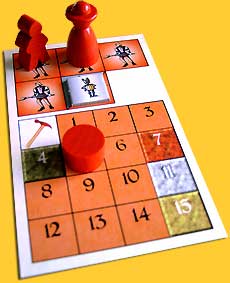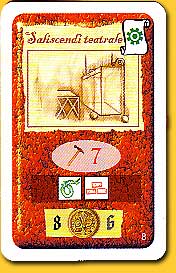Leonardo da Vinci / Maestro Leonardo
Author: Acchittocca
Publisher: daVinci Games
Year: 2006
review by

| x |
|
|
|
|
|
|
|
|
|
|
|
|
|
|
|
|
|
|
|
|
|
|
|
|
|
|
|
|
|
|
|
|
|
|
|
|
|
|
|
|
|
|
|
|
|
 |
Leonard da Vinci was a busy man: architect, sculptor, musician, poet, mathematician, astronomer, fysician, chemist, anatomist, botanist, geographer, geologist, optician and last but not least engineer. He’d better get a hand in the realisation of all his ingenious works and this is done by buying materials, improve workshops and hiring labourers that can be done on various places in an abstract city. When an invention is completed, the players get paid for it. They do not have much time, after seven rounds the city closes its gates and only the studios may continue to work on current or new inventions. The player who has collected the most money after the ninth round, has won the game. |
The two to five players act as the guild master, and together with their pupils they work on the inventions that are to be completed and in this way they follow the foot steps of the master that Leonardo was. Each player starts with a different set of tools; one player has more money, another with more or different materials, laboratories, or pupils.
The map depicts a town where they can get the resources needed for the various inventions, but at first sight only the schematic and abstract rectangles dominate: spaces for glass, tools, rope and brick, and spaces to place the players tokens. If placed more than another player, a player may perform his action first without payment, in case of the materials this means he may take a free material card.
Players next in line will have to pay: two to four gold. When tied, the player that put his tokens first on the specific location breaks the tie and goes first. |
|
 |
| x |
|
|
 |
Apart from acquiring materials players can place their tokens at the laboratory site to get new laboratories or improve existing ones, or go to the labor market to hire a new pupil. When upgrading a laboratory, the amount of pupils it can hold increases, and there is room for one or more robots. If the laboratory is prepared for a robot, the player may also take or buy one at the laboratory site. The robot, once placed in a laboratory, is an integral part of of it and automatically speeds up the completion of any future invention.
Each round the laboratories will have to be manned in order to continue the invention, and a player chooses, as one of his actions during the placement phase, whether to place one or more tokens in the city, or in his laboratory. He is not allowed to place additional tokens at the same location in a later turn during the placement phase, except for the master token that counts as two pupils and that may be placed in any following turn, mainly to get or regain a majority at a hot spot. |
| x |
|
|
|
|
|
|
|
|
|
|
|
|
|
|
|
|
|
|
|
|
|
|
|
|
|
|
|
|
|
|
|
|
|
|
|
|
|
|
|
|
|
|
|
|
|
| This way the second phase of a round is continued until each player has placed all his tokens; during the first phase each player already decided if he wanted to start a new invention. On the map, dependent on the amount of players, three to five invention cards are drawn and turned open. These cards show the necessary materials, and the number of weeks that it takes for a laboratory to complete the invention. Each pupil in a laboratory advances the project one week, each master or robot two weeks. If a player decides to work on an invention, he places the necessary material cards under his laboratory card; other players do not know on which invention a player is working - they do know that the laboratory is active. Once active, a laboratory may not be upgraded or equipped with a robot, nor may the materials in the laboratory be changed. |
|
 |
|
|
|
|
|
|
|
|
|
|
|
|
|
|
|
|
|
|
|
|
|
|
|
|
|
|
|
|
|
|
|
|
|
|
|
|
|
|
|
|
|
|
|
|
|
|
 |
|
During the third phase all locations in the town are scored, starting with the council. On this space a player with the majority of tokens has the first pick of four, for each player free choices: move an already placed pupil to a different location (and in doing so acquire the majority, or go to a location that has been left empty, with the same result); take the gold from the joining space where each new round 1 (additional) gold is placed; buy any one material for 1 gold; or look at the first four invention card in the stack and rearrange them at will - in this way a player is able to anticipate on future projects not known to other players. Subsequently the rest of the town is visited and scored; after this the pupils and the master return to the players stock. |
| x |
|
|
|
|
|
|
|
|
|
|
|
|
|
|
|
|
|
|
|
|
|
|
|
|
|
|
|
|
|
|
|
|
|
|
|
|
|
|
|
|
|
|
|
|
|
| x |
|
|
|
|
|
|
|
|
|
|
|
|
|
|
|
|
|
|
|
|
|
|
|
|
|
|
|
|
|
|
|
|
|
|
|
|
|
|
|
|
|
|
|
|
|
 |
|
|
|
|
|
|
|
|
|
|
|
|
|
|
|
|
|
|
|
|
|
|
|
|
|
|
|
|
|
|
|
|
|
|
|
|
|
|
|
|
|
 |
|
|
|
|
|
|
|
|
|
|
|
|
|
|
|
|
|
|
|
|
|
|
|
|
|
|
|
|
|
|
|
|
|
|
|
|
|
|
|
|
|
 |
|
|
|
|
|
|
|
|
|
|
|
|
|
|
|
|
|
|
|
|
|
|
|
|
|
|
|
|
|
|
|
|
|
|
|
|
|
|
|
|
|
| x |
|
|
|
|
|
|
|
|
|
|
|
|
|
|
|
|
|
|
|
|
|
|
|
|
|
|
|
|
|
|
|
|
|
|
|
|
|
|
|
|
|
|
|
|
|
 |
|
|
|
|
|
|
|
|
|
|
|
|
|
|
|
|
|
|
|
|
|
|
|
|
|
|
|
|
|
|
|
|
|
 |
|
|
|
|
|
|
|
|
|
|
|
|
|
|
|
|
|
|
|
|
|
|
|
|
|
|
|
|
|
|
|
|
|
|
|